一般过去时变疑问句规则及肯定否定
- 格式:docx
- 大小:8.17 KB
- 文档页数:2
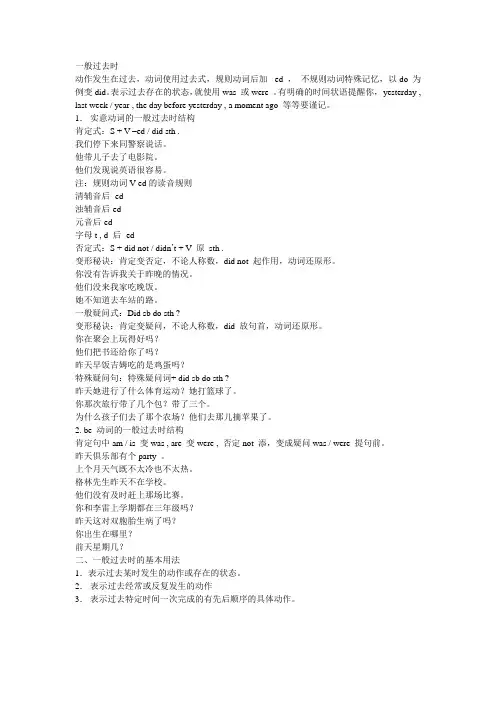
一般过去时动作发生在过去,动词使用过去式,规则动词后加- ed ,不规则动词特殊记忆,以do 为例变did。
表示过去存在的状态,就使用was 或were 。
有明确的时间状语提醒你,yesterday , last week / year , the day before yesterday , a moment ago 等等要谨记。
1.实意动词的一般过去时结构肯定式:S + V –ed / did sth .我们停下来同警察说话。
他带儿子去了电影院。
他们发现说英语很容易。
注:规则动词V-ed的读音规则清辅音后- ed浊辅音后-ed元音后-ed字母t , d 后- ed否定式:S + did not / didn’t + V 原sth .变形秘诀:肯定变否定,不论人称数,did not 起作用,动词还原形。
你没有告诉我关于昨晚的情况。
他们没来我家吃晚饭。
她不知道去车站的路。
一般疑问式:Did sb do sth ?变形秘诀:肯定变疑问,不论人称数,did 放句首,动词还原形。
你在聚会上玩得好吗?他们把书还给你了吗?昨天早饭吉姆吃的是鸡蛋吗?特殊疑问句:特殊疑问词+ did sb do sth ?昨天她进行了什么体育运动?她打篮球了。
你那次旅行带了几个包?带了三个。
为什么孩子们去了那个农场?他们去那儿摘苹果了。
2. be 动词的一般过去时结构肯定句中am / is 变was , are 变were , 否定not 添,变成疑问was / were 提句前。
昨天俱乐部有个party 。
上个月天气既不太冷也不太热。
格林先生昨天不在学校。
他们没有及时赶上那场比赛。
你和李雷上学期都在三年级吗?昨天这对双胞胎生病了吗?你出生在哪里?前天星期几?二、一般过去时的基本用法1.表示过去某时发生的动作或存在的状态。
2.表示过去经常或反复发生的动作3.表示过去特定时间一次完成的有先后顺序的具体动作。
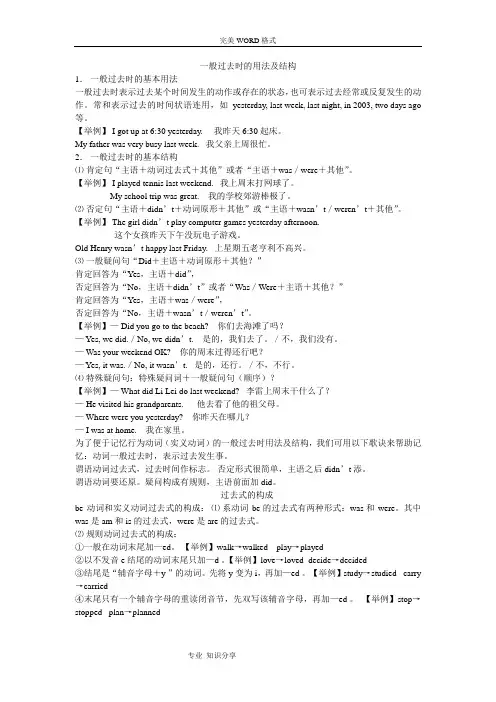
一般过去时的用法及结构1.一般过去时的基本用法一般过去时表示过去某个时间发生的动作或存在的状态,也可表示过去经常或反复发生的动作。
常和表示过去的时间状语连用,如yesterday, last week, last night, in 2003, two days ago 等。
【举例】 I got up at 6:30 yesterday. 我昨天6:30起床。
My father was very busy last week. 我父亲上周很忙。
2.一般过去时的基本结构⑴肯定句“主语+动词过去式+其他”或者“主语+was/were+其他”。
【举例】 I played tennis last weekend. 我上周末打网球了。
My school trip was great. 我的学校郊游棒极了。
⑵否定句“主语+didn’t+动词原形+其他”或“主语+wasn’t/weren’t+其他”。
【举例】 The girl didn’t play computer games yesterday afternoon.这个女孩昨天下午没玩电子游戏。
Old Henry wasn’t happy last Friday. 上星期五老亨利不高兴。
⑶一般疑问句“Did+主语+动词原形+其他?”肯定回答为“Yes,主语+did”,否定回答为“No,主语+didn’t”或者“Was/Were+主语+其他?”肯定回答为“Yes,主语+was/were”,否定回答为“No,主语+wasn’t/weren’t”。
【举例】— Did you go to the beach? 你们去海滩了吗?— Yes, we did./No, we didn’t. 是的,我们去了。
/不,我们没有。
— Was your weekend OK? 你的周末过得还行吧?— Yes, it was./No, it wasn’t. 是的,还行。
/不,不行。
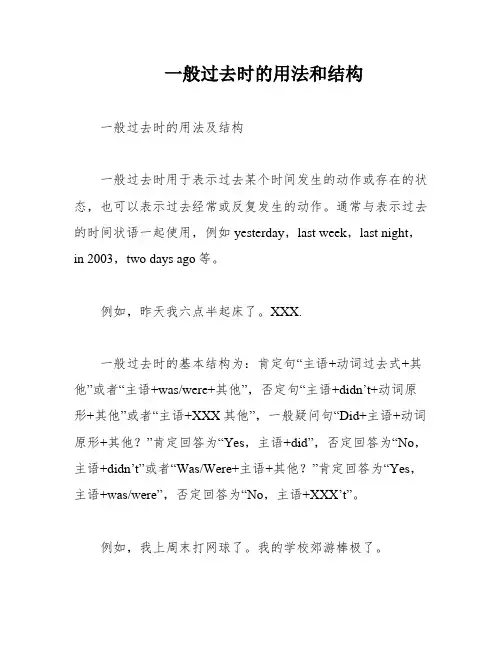
一般过去时的用法和结构一般过去时的用法及结构一般过去时用于表示过去某个时间发生的动作或存在的状态,也可以表示过去经常或反复发生的动作。
通常与表示过去的时间状语一起使用,例如yesterday,last week,last night,in 2003,two days ago等。
例如,昨天我六点半起床了。
XXX.一般过去时的基本结构为:肯定句“主语+动词过去式+其他”或者“主语+was/were+其他”,否定句“主语+didn’t+动词原形+其他”或者“主语+XXX其他”,一般疑问句“Did+主语+动词原形+其他?”肯定回答为“Yes,主语+did”,否定回答为“No,主语+didn’t”或者“Was/Were+主语+其他?”肯定回答为“Yes,主语+was/were”,否定回答为“No,主语+XXX’t”。
例如,我上周末打网球了。
我的学校郊游棒极了。
这个女孩昨天下午没玩电子游戏。
上星期五老XXX不高兴。
特殊疑问句的结构为:特殊疑问词+一般疑问句(顺序)?例如,XXX上周末干什么了?他去看了他的祖父母。
你昨天在哪儿?我在家里。
为了帮助记忆实义动词一般过去时的用法和结构,我们可以使用以下歌诀:“动词一般过去时,表示过去发生事。
谓语动词过去式,过去时间作标志。
否定形式很简单,主语之后加didn't。
谓语动词要还原。
疑问构成有规则,主语前面加did。
”过去式的构成有两种方式:be动词和实义动词。
系动词be的过去式有两种形式:was和were。
其中,was是am和is的过去式,were是are的过去式。
实义动词过去式的构成有以下几种规则:1.一般在动词末尾加-ed,例如walk→walked,play→played;2.以不发音e结尾的动词末尾只加-d,例如love→loved,decide→decided;3.以“辅音字母+y”结尾的动词,先将y变为i,再加-ed,例如study→studied,carry→carried;4.末尾只有一个辅音字母的重读闭音节,先双写该辅音字母,再加-ed,→ped,plan→planned。
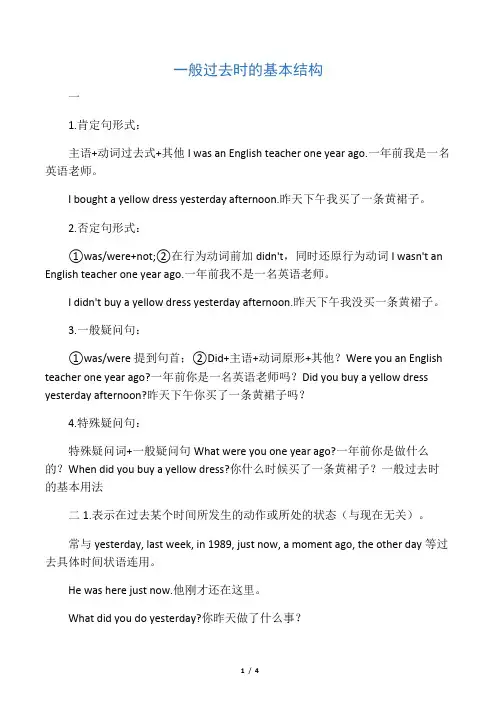
一般过去时的基本结构一1.肯定句形式:主语+动词过去式+其他I was an English teacher one year ago.一年前我是一名英语老师。
I bought a yellow dress yesterday afternoon.昨天下午我买了一条黄裙子。
2.否定句形式:①was/were+not;②在行为动词前加didn't,同时还原行为动词I wasn't an English teacher one year ago.一年前我不是一名英语老师。
I didn't buy a yellow dress yesterday afternoon.昨天下午我没买一条黄裙子。
3.一般疑问句:①was/were提到句首;②Did+主语+动词原形+其他?Were you an English teacher one year ago?一年前你是一名英语老师吗?Did you buy a yellow dress yesterday afternoon?昨天下午你买了一条黄裙子吗?4.特殊疑问句:特殊疑问词+一般疑问句What were you one year ago?一年前你是做什么的?When did you buy a yellow dress?你什么时候买了一条黄裙子?一般过去时的基本用法二1.表示在过去某个时间所发生的动作或所处的状态(与现在无关)。
常与yesterday, last week, in 1989, just now, a moment ago, the other day等过去具体时间状语连用。
He was here just now.他刚才还在这里。
What did you do yesterday?你昨天做了什么事?2.在过去一段时间内的经常性或习惯性动作。
We often played together when we were children.我们小时候常在一起玩。

一般过去时及动词过去式变化规则一般过去时:表示过去发生的动作或存在的状态。
结构:谓语动词为动词的过去式。
经常跟表示过去的时间连用:yesterday, last night /last year / last month/ last month比如:I went home yesterday.I played football last Sunday.肯定句:I went home yesterday.否定句:I didn't go home yesterday. (did not = didn't)一般疑问句:Did you go home yesterday?特殊疑问句:Where did you go yesterday?肯定句:I was at home last night.否定句:I wasn't at home last night. (was not = wasn't)一般疑问句:Were you at home last night?特殊疑问句:Where were you at home last night?动词过去式变化规则1. 一般情况下直接加-ed, work--workedwalk-- walked help--helped play--played2. 以不发音的字母e结尾的动词,加d, dance--danced like-liked3. 以重读闭音节结尾,而且结尾只有一个辅音字母,双写这个辅音字母,再加ed, plan--planned, stop--stopped, shop--shopped4. 以辅音字母加y结尾的动词,把y变成i,再加ed, try-- tried, study--studied5. 不规则动词的变化:take--took, have--had, see--saw, draw--drew, come--came, give--gave, sit--sat, sing--sang, swim--swam, drink--drank, run--ran, put --put read--read, buy--bought, am/is--was are--were , do --did, go --went, make---made。

新一般过去时的一般疑问句及疑问句集团文件发布号:(9816-UATWW-MWUB-WUNN-INNUL-DQQTY-一般过去时的一般疑问句和否定句学号姓名一、含有行为动词的一般疑问句为“Did…?”“Yes, …did”“No, …didn′t”口诀: did 提前动词还原。
一般疑问句的结构为“Did+主语+动词原形+其它”二、否定句:主语+ didn’t+动词原形+其它练习:将下列句子改成一般疑问句和否定句。
1.The kite flew away. 一般疑问句及回答否定句2.We saw many interesting parrots. 一般疑问句及回答否定句3.I brought some bread and honey. 一般疑问句及回答否定句4.The weather became windy and rainy.一般疑问句及回答否定句5.It rained. 一般疑问句及回答否定句6.They went to the park by bike .一般疑问句及回答否定句7.The children could eat their lunch.一般疑问句及回答否定句8.He visited the Palace Museum .一般疑问句及回答否定句9. I caught some fish. 一般疑问句及回答否定句10. They ate a big fish. 一般疑问句及回答否定句一般过去时的特殊疑问句(课堂练习)学号姓名由特殊疑问词引导的问句叫特殊疑问句。
通常句子结构为:特殊疑问词+一般疑问句一般过去时含行为动词的特殊疑问句结构为:特殊疑问词+did+主语+动词原形+其它练习:对下列句中的划线部分提问。
1.I visited the Shanghai Museum two days ago.the Shanghai Museum two days ago ?2.Liu Tao went to the Bund for the National Day Holiday.Liu Tao for the National Day Holiday3.Mike caught a big fish last week.Mike last week?4.I called you because I wanted to give the fish.you me ?5.We picked some oranges and went fishing on the farm.you on the farm ?6.My holiday was great fun.holiday ?7.Our family went to a farm near Star Lake.your family ?8.The boy saw many interesting things in the Museum .the boy in the museum ?9.Mr Green told the boy a story.the boy a story?10.They went to school by bus this morning.they to school this morning? 11.These are LiuTao’s pencils.are ?12.My father was 58 years old last year.father last year?。

一般过去时用法描述一般过去时是英语语法中的一种时态,用于描述发生在过去的动作、事件或状态。
在构成上,一般过去时的动词形式为动词的过去式,通常是动词原形加上-ed结尾,或者根据动词的变化规则来变化。
一般过去时除了描述过去的动作之外,还可以用于表达过去的习惯、习惯性行为或者过去的真实情况。
在进行详细描述时,可以从一般过去时的构成、用法及常见错误等方面进行阐述。
接下来,我们将着重介绍一般过去时的用法,以及一些注意事项。
一、一般过去时的用法:1. 表示过去的动作或事件:一般过去时常用来描述过去发生的动作或事件,例如:- She visited her grandparents last summer.(她去年夏天拜访了她的祖父母。
)- They went to the park yesterday.(他们昨天去了公园。
)2. 表示过去的习惯或习惯性行为:一般过去时也可以用来描述过去的习惯或经常发生的行为,例如:- When I was a child, I played with my friends every day.(我小的时候,每天都和朋友们一起玩。
)- He always helped his mother with the housework.(他总是帮他妈妈做家务。
)3. 表示过去的真实情况:一般过去时还可以用来表示过去的真实情况,例如:- I thought he was a nice person.(我当时以为他是一个好人。
)- The sky was clear and the sun was shining.(天空晴朗,阳光灿烂。
)二、一般过去时的构成:一般过去时的构成主要取决于动词的不规则变化规则和规则变化规则。
不规则动词的过去式形式需要单独记忆,而规则动词的过去式则通常是在动词后面加上了-ed结尾。
以下是一般过去时的构成规则的主要内容:1. 一般动词(regular verbs):- 动词原形+ed结尾,例如:walked, talked, played等。
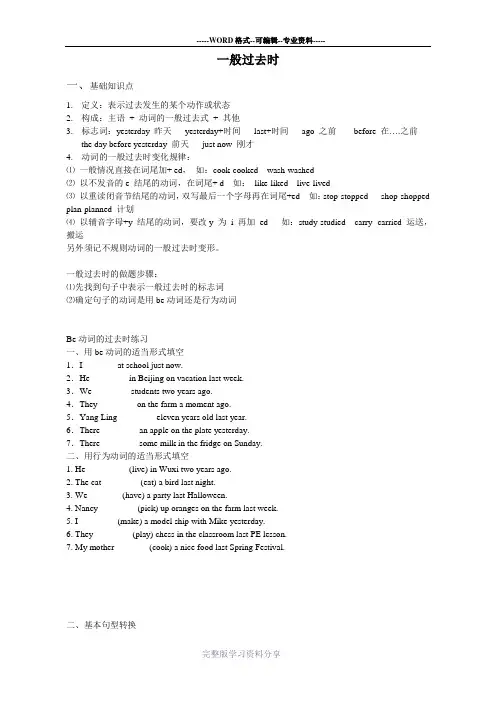
一般过去时一、基础知识点1.定义:表示过去发生的某个动作或状态2.构成:主语+ 动词的一般过去式+ 其他3.标志词:yesterday 昨天yesterday+时间last+时间ago 之前before 在….之前the day before yesterday 前天just now 刚才4.动词的一般过去时变化规律:⑴一般情况直接在词尾加+ ed,如:cook-cooked wash-washed⑵以不发音的e 结尾的动词,在词尾+ d 如:like-liked live-lived⑶以重读闭音节结尾的动词,双写最后一个字母再在词尾+ed 如:stop-stopped shop-shopped plan-planned 计划⑷以辅音字母+y 结尾的动词,要改y 为i 再加ed 如:study-studied carry- carried 运送,搬运另外须记不规则动词的一般过去时变形。
一般过去时的做题步骤:⑴先找到句子中表示一般过去时的标志词⑵确定句子的动词是用be动词还是行为动词Be动词的过去时练习一、用be动词的适当形式填空1.I _______ at school just now.2.He ________ in Beijing on vacation last week.3.We ________ students two years ago.4.They ________ on the farm a moment ago.5.Yang Ling ________ eleven years old last year.6.There ________ an apple on the plate yesterday.7.There ________ some milk in the fridge on Sunday.二、用行为动词的适当形式填空1. He _________ (live) in Wuxi two years ago.2. The cat ________ (eat) a bird last night.3. We _______ (have) a party last Halloween.4. Nancy ________ (pick) up oranges on the farm last week.5. I ________ (make) a model ship with Mike yesterday.6. They ________ (play) chess in the classroom last PE lesson.7. My mother _______ (cook) a nice food last Spring Festival.二、基本句型转换1.一般过去时的否定句构成:有be 动词和没有be 动词两种情况⑴如果有be动词,要先找到be 动词,再在be动词后加not即主语+ be + not + 其他举例:She was very happy.分析:She 为句子主语,was 为be 动词,故She was not very happy. was not= wasn’t⑵如果没有be 动词,我们就要借用助动词didn’t, 并放在动词前面。
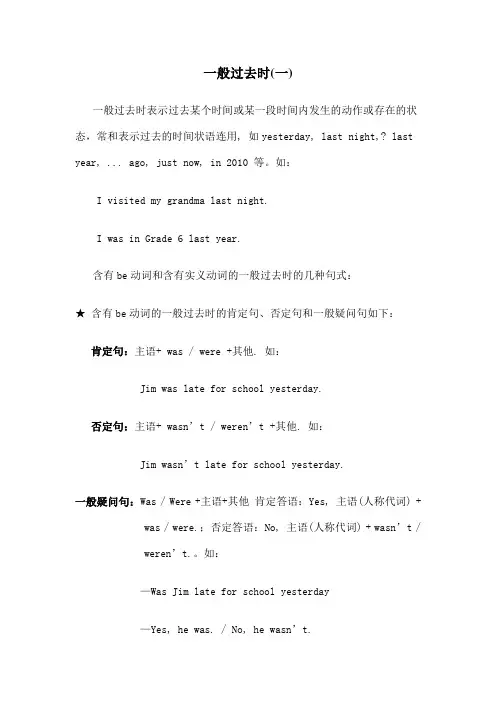
一般过去时(一)一般过去时表示过去某个时间或某一段时间内发生的动作或存在的状态,常和表示过去的时间状语连用, 如yesterday, last night,? last year, ... ago, just now, in 2010 等。
如:I visited my grandma last night.I was in Grade 6 last year.含有be动词和含有实义动词的一般过去时的几种句式:★ 含有be动词的一般过去时的肯定句、否定句和一般疑问句如下:肯定句:主语+ was / were +其他. 如:Jim was late for school yesterday.否定句:主语+ wasn’t / weren’t +其他. 如:Jim wasn’t late for school yesterday.一般疑问句:Was / Were +主语+其他肯定答语:Yes, 主语(人称代词) + was / were.;否定答语:No, 主语(人称代词) + wasn’t /weren’t.。
如:—Was Jim late for school yesterday—Yes, he was. / No, he wasn’t.说明:was / were根据主语的变化而变化(主语为代词I, he, she, it ,可数名词的单数形式及不可数名词时用was;主语为代词we, you,they及可数名词的复数形式时用were)。
★ 含有实义动词的一般过去时的肯定句、否定句和一般疑问句如下:肯定句:主语+动词的过去式+其他. 如:Mike came to China in 2010.否定句:主语+ didn’t + 动词原形+其他. 如:Mike didn’t come to China in 2010.一般疑问句:Did +主语+动词原形+其他肯定答语:Yes, 主语(人称代词) + did.;否定答语:No, 主语(人称代词) + didn’t.。

(完整版)⼀般过去时态总结关于⼀般过去时态⼀、定义英语中表⽰过去某时发⽣的动作或情况的时态是⼀般过去时。
⼆、⼀般过去时的表现形式⼀般过去时⽤动词过去式表⽰。
动词过去式按其构成形式有规则和不规则变化两种情况。
规则动词的过去式⼀般直接在词尾加-ed,即:动词原形+ ed;⽆规则变化的需要边学边记。
作谓语的⾏为动词的词尾变化如下:⼀般情况+ed以e字母结尾的辅⾳+d以辅⾳字母+y结尾去y变i+ed重读闭⾳节结尾的单词,末尾只有⼀个辅⾳字母双写词尾字母+ed部分常⽤不规则动词的过去时:动词原形过去式含义1.bring brought带来2.build built建4.buy bought买5.catch caught抓6.dig dug挖7.feel felt感觉8.fight fought打架9.find found发现10.get got得到11.hang hung悬挂12.have had有13.hear heard听到14.hold held握15.keep kept保持17.leave left离开18.lend lent借出19.lose lost丢失20.make made制造22.meet met遇到23.pay paid付款24.say said说25.sell sold卖26.send sent送28.sit sat坐29.sleep slept睡3.spend spent花费32.stand stood站3.sweep swept扫34.teach taught教35.tell told告诉36.think thought想38.win won赢三、⼀般过去时的⼏个时间状语yesterday(昨天)、two days ago…(两天前…… )、last year…(去年…)、the other day(前⼏天)、once upon a time(很久以前)、just now(刚才)、in the old days(过去的⽇⼦⾥)、before liberation(解放前…)、When I was 8 years old(当我⼋岁时…)、at+⼀个时间点(注:“过去”的概念并不是只指如“yesterday, last week,…”等,实际上“与现在对⽴的过去”,亦即“⾮现在的以前”,哪怕是“过了说话时间的⼏分钟之前”,只要所要表达的时间与说话时的“现在”形成对⽴,就必须使⽤⼀般过去时来表达。
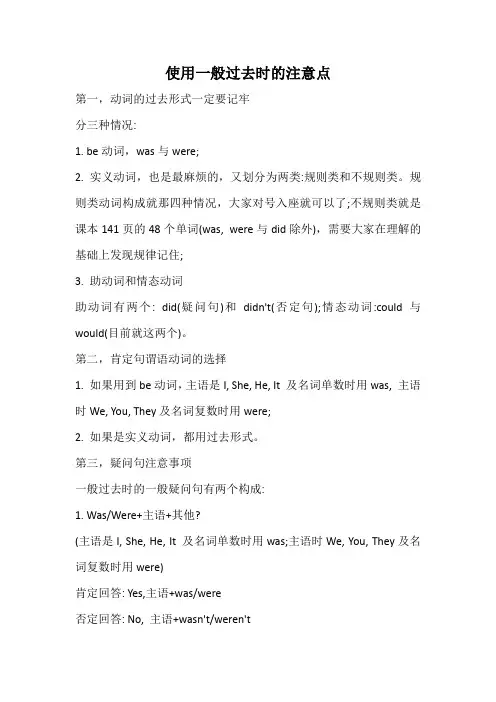
使用一般过去时的注意点第一,动词的过去形式一定要记牢分三种情况:1. be动词,was与were;2. 实义动词,也是最麻烦的,又划分为两类:规则类和不规则类。
规则类动词构成就那四种情况,大家对号入座就可以了;不规则类就是课本141页的48个单词(was, were与did除外),需要大家在理解的基础上发现规律记住;3. 助动词和情态动词助动词有两个: did(疑问句)和didn't(否定句);情态动词:could与would(目前就这两个)。
第二,肯定句谓语动词的选择1. 如果用到be动词,主语是I, She, He, It 及名词单数时用was, 主语时We, You, They及名词复数时用were;2. 如果是实义动词,都用过去形式。
第三,疑问句注意事项一般过去时的一般疑问句有两个构成:1. Was/Were+主语+其他?(主语是I, She, He, It 及名词单数时用was;主语时We, You, They及名词复数时用were)肯定回答: Yes,主语+was/were否定回答: No, 主语+wasn't/weren'teg: -Was he at the zoo yesterday?昨天他在动物园吗?-Yes, he was.-Were you at home last night?昨天晚上你们在家吗?-No, we weren't. 不,我们不在。
-Was the girl in the classroom this morning?今天晚上这个女孩在教室里吗?-No, she wasn't. 不,她不在。
-Were the pandas cute?熊猫可爱吗?-Yes, they were. 是的,它们很可爱。
2. Did +主语+动词原形+其他?(不考虑主语的单复数)肯定回答: Yes, 主语+did否定回答:No, 主语+didn'teg: -Did you milk a cow?你给奶牛挤奶了吗?-Yes, I did. 是的。
(知识点)理解一般过去时的肯定否定和疑问句理解一般过去时的肯定、否定和疑问句一、肯定句一般过去时表示过去发生的动作或状态,肯定句的结构为:“主语 + 动词过去式 + 其他”。
例如:- She studied English last night.- We went camping last summer.二、否定句在一般过去时的否定句中,使用助动词"did not"或其缩写形式"didn't"来构成。
句子结构为:“主语 + did not + 动词原形 + 其他”。
例如:- He did not watch TV yesterday.- They didn't play football last weekend.三、疑问句1. 一般疑问句构成一般过去时的疑问句需要将助动词"did"提到句子的主语之前,句子结构为:“Did + 主语 + 动词原形 + 其他?”例如:- Did she go to the party?- Did they eat dinner at home?2. 特殊疑问句特殊疑问句是以疑问词引导的疑问句,疑问词可以是who, what, where, when, why, how等。
在一般过去时的特殊疑问句中,同样需要将助动词"did"放在疑问词之前,句子结构为:“疑问词 + did + 主语 + 动词原形 + 其他?”例如:- What did you do yesterday?- Where did they go for vacation?说明:- 一般过去时的肯定句中,动词需要变为过去式,例如:study变为studied, go变为went。
- 否定句和疑问句中都使用助动词"did",而动词恢复为原形。
注意助动词"did"本身表示过去时,所以后面的动词是原形。
一般过去时变一般疑问句方法一般过去时是指在过去发生的动作或事件,这种时态的句子构成非常简单,通常由主语+动词过去式+其他成分构成,如:Tom went to the mall.(汤姆去了商场)。
但是当我们想要询问别人关于过去发生的事情时,就需要使用一般过去时的疑问句形式了。
接下来,我们将详细讲解一般过去时疑问句的形式和用法。
一、一般过去时疑问句的形式一般过去时的疑问句是由助动词did加上主语和动词原形来构成的,如下所示:Did + 主语 + 动词原形(Did + subject + verb base form)例如:Did you study last night? (你昨晚有学习吗?)Did they go to the party on Saturday? (他们周六去参加派对了吗?)Did Tom finish his homework yesterday? (汤姆昨天完成了他的作业吗?)二、一般过去时疑问句的用法1. 询问过去的情况或事件一般过去时的疑问句通常用于询问过去所发生的情况或事件。
在这种情况下,我们可以使用如下的疑问句:Did you eat breakfast this morning? (你今天早上吃早餐了吗?)Did she call you last night? (昨晚她打电话给你了吗?)Did they see the movie last night? (他们昨晚看了电影吗?)2. 确认或认可陈述一般过去时的疑问句可以用于确认或认可某个陈述。
在这种情况下,我们使用的疑问句的语音通常是上扬的,因为我们希望得到对方的肯定或认可。
以下是一些例子:You went to the gym yesterday, didn't you? (你昨天去了健身房,不是吗?)He finished his homework, didn't he? (他完成了他的作业,不是吗?)They left early, didn't they?(他们离开得挺早,不是吗?)3. 强调一般过去时的疑问句还可以用于强调某个事实或情况。
小学英语一般过去时语法详解一、概念表示在的过去某个时间里所发生的动作或存在的状态。
通常在句子里找到表示过去时间的词或词组。
如:yesterday,yesterday morning,yesterday afternoon,yesterday evening,the day before yesterday(前天),last night,last week,last month,last year,a moment ago(刚才),just now(刚才),two days ago,a week ago,in 1990等。
如:I went to bed at eleven last night.昨晚我11:00睡觉。
二、动词过去式的构成规律(一)规则动词的过去式1、一般情况下,在动词原形后面加-ed;如:look→looked play→playe d;2、以不发音e结尾的动词,在词尾直接加-d;如:live→lived use→used;3、以“辅音字母+ y”结尾的动词,先将y 改为i ,再加–ed;如:study→studied, try→triedfly→flied4、以重读闭音节(即辅音+元音+辅音)或r音节结尾,末尾只有一个辅音字母的动词,要先双写这个辅音字母后,再加–ed。
如:stop→stoppedplan→planned;(二)不规则动词的过去式(后附不规则动词变化表)1、改变动词中的元音;begin→began drink→drank come→came eat→ate grow→grew run→ran know→knew win→wonspeak→spoketake→took write→wrote get→got2、变词尾的–d 为–t ;bu ild→built lend→lent send→sent spend→spent bend→bent3、与动词原形一样;cut→cut put→put cost→cost hurt→hurt shut→shut4、变-ay 为-aid (少数动词);say→said pay→paid lay→laid5、采用不同词根;sell→sold teach→taught buy→bought6、其他。
动词的一般过去时否定形式动词的时态是语法中非常重要的一部分。
其中,一般过去时是描述过去发生的动作、事情或状态的一种时态。
在英语中,构成一般过去时的肯定形式很简单,只需在动词原型后加上-ed或-d。
然而,一般过去时的否定形式则需要使用助动词“did not”或其缩写形式“didn't”,并在其后紧接动词原型。
本文将详细探讨动词的一般过去时否定形式的用法和注意事项。
一、构成方式动词的一般过去时否定形式,即在动词原型后面添加助动词“did not”或“didn't”。
这里需要注意的是,只有助动词“did”变为否定形式“did not”或“didn't”,而实义动词本身不需变化,仍保持原型形式。
例如:原句(肯定句):He played basketball yesterday.否定形式:He did not play basketball yesterday. / He didn't play basketball yesterday.二、用法示例下面通过几个例子来说明动词的一般过去时否定形式的用法。
1. 表示否定的陈述句肯定句:She watched a movie last night.否定句:She did not watch a movie last night. / She didn't watch a movie last night.2. 表示否定的一般疑问句肯定句:They visited their grandparents.否定句:Did they not visit their grandparents? / Didn't they visit their grandparents?3. 表示否定的特殊疑问句(以疑问词开头)肯定句:He ate breakfast at home.否定句:Where did he not eat breakfast? / Where didn't he eat breakfast?4. 表示否定的祈使句肯定句:Come to the party tomorrow.否定句:Do not come to the party tomorrow. / Don't come to the party tomorrow.三、注意事项在使用动词的一般过去时否定形式时,需要注意以下几点:1. 助动词“did”在否定形式中需要发音缩写为“didn't”。
般过去时的用法:般过去时表示过去某个时间发生的动作或存在的状态,般过去时也表示过去经常或反复发生的动作。
Be动词在一般过去时中的变化:⑴am 和is 在一般过去时中变为was°(was not=wasn't⑵are在一般过去时中变为wereo( were not=weren 't⑶带有was或were的句子,其否定、疑问的变化和is\am,\are—样即否定句在was或were后加not,—般疑问句把was或were放到句首。
句中没有be动词的一般过去时的句子否定句:didn ' + 动词原形,如:Jim didn ' go home yesterday.一般疑问句:在句首加did,句子中的动词过去式变回原形。
如: Did Jim go home yesterday?特殊疑问句:⑴疑问词+did+主语+动词原形?如:What did Jim do yesterday?⑵疑问词当主语时:疑问词+动词过去式?如:Who we nt to home yesterday?动词过去式变化规则:1.一般在动词末尾加-ed,如:pull-pulled, cook-cooked2.结尾是e加d,如:taste-tasted3.末尾只有一个元音字母和一个辅音字母的重读闭音节,应双写末尾的辅音字母,再力卩-ed,如:stop-stopped plan-planned4.以辅音字母+y”结尾的,变y为i,再加-ed,如:study-studied5.不规则动词过去式:一般过去时常和last night(week \ month~) , in 1999 , yesterday , the day b efore yesterday , yesterday morning , just now , ago , two days ago(一段时间+ago) , at the age of 14 , in the past , one day , at that time ,long long ago过去时练习:写出下列动词的过去式is\am ______________ fly __________ plant ______________ are ______________ drink ______一、用be动词的适当形式填空。
一般过去时:表示过去发生的动作或事件,常和表示过去的时间状语连用,如yesterday, last night, the day before yesterday, 3 days ago,
含有be动词的句子,将动词变为过去式,am, is的过去式为was,are 的过去式为were
I was at the butcher ' s.
You were a student a year ago.
The teacher was very beautiful ten years ago.
★变疑问句将be 动词移动到句首
Were you at the butcher ' s?
Were you a student a year ago?
Was the teacher very beautiful ten years ago?
★变否定句在be 动词后面加not
I was not at the butcher ' s.
You were not a student a year ago.
The teacher was not very beautiful ten years ago. ★肯定回答否定回答
Yes, I was. No, I was not.
Yes, you were. No, you were not.
Yes, he/she was. No, he/she was not.
★特殊疑问句:
What did you do?
(必背)
不含有be 动词的句子,将动词变为过去式,动词过去式构成见
附录
I finished my homework yesterday.
The boy went to a restaurant.
The Sawyers lived at King Streeta year ago.
★ 变疑问句在句首加did ,动词变为原型
Did you finish your homework yesterday?
Did the boy go to a restaura nt?^变否定句在主语和动词之间加did n otl did not finish my homework yesterday.The boy did not go to a restaurant.The Sawyers did not live at King Streeta year ago* 肯定回答及否定回答
Yes, l did. No, l didn ' t.
Yes, he did. No, he didn ' t.
Yes, they did. No, they did not.。